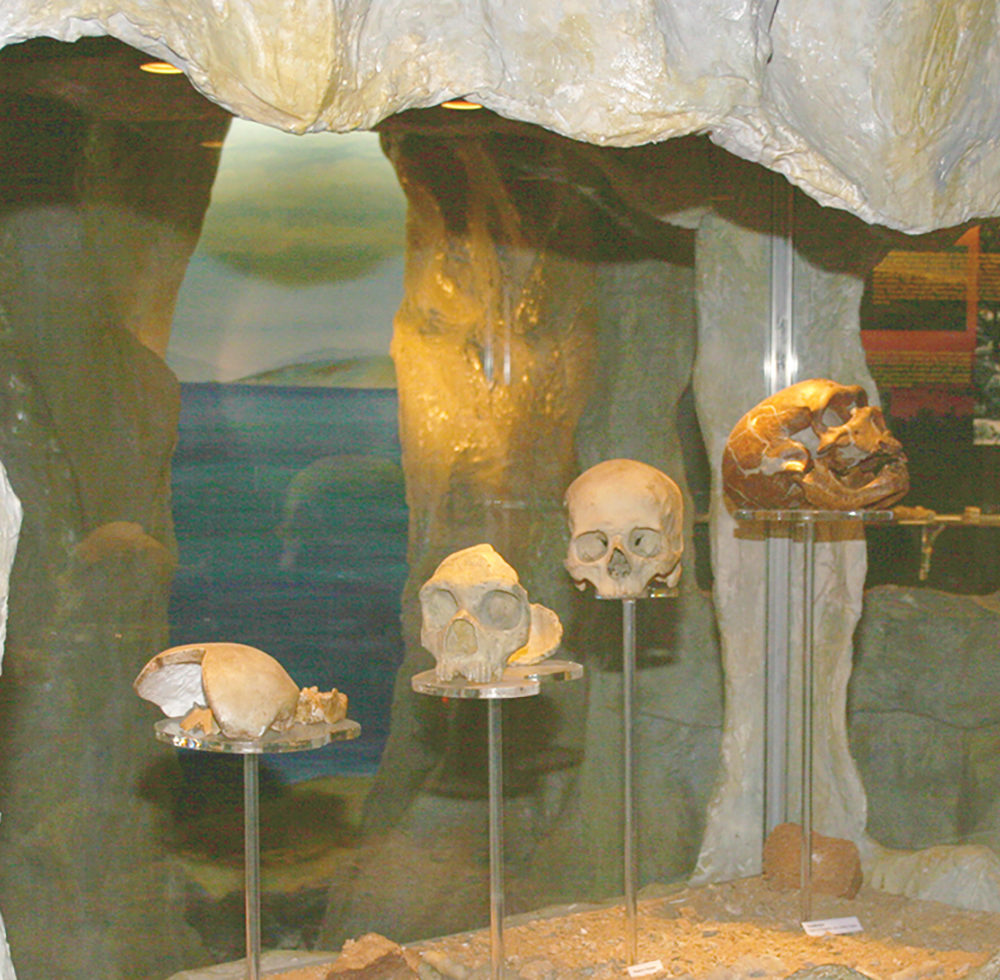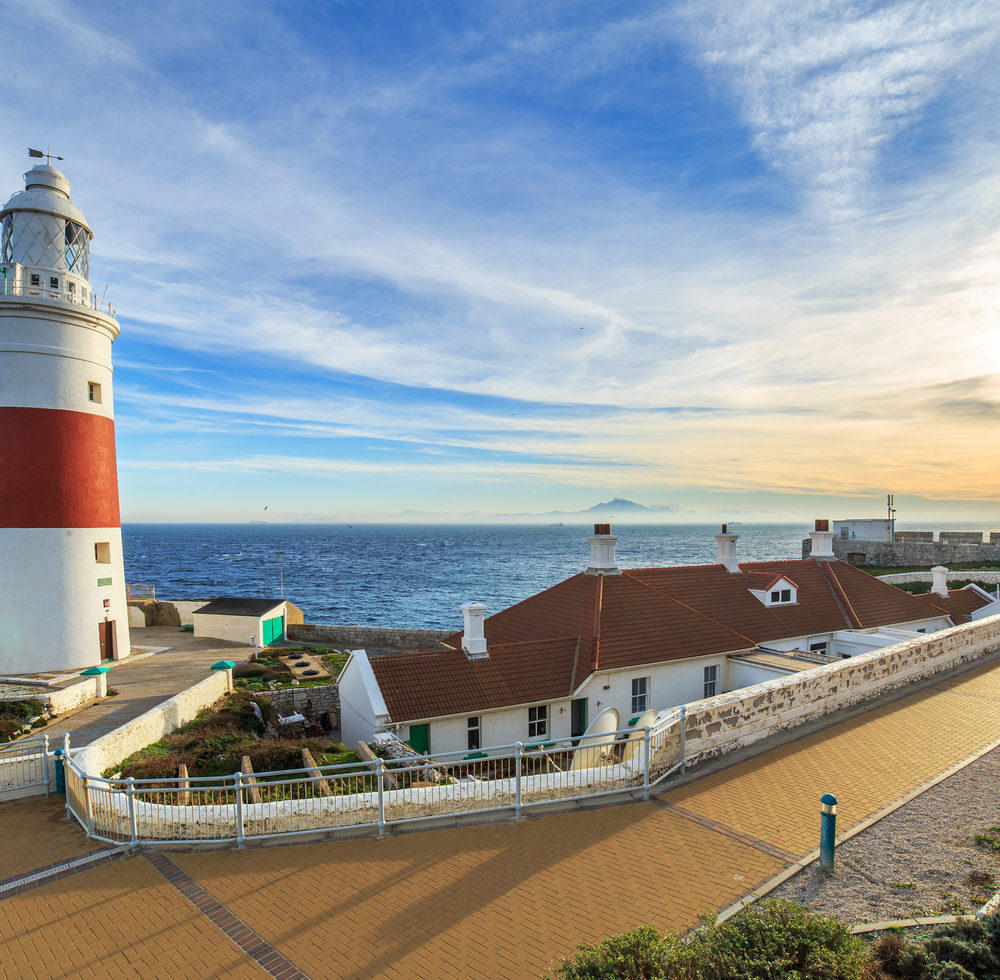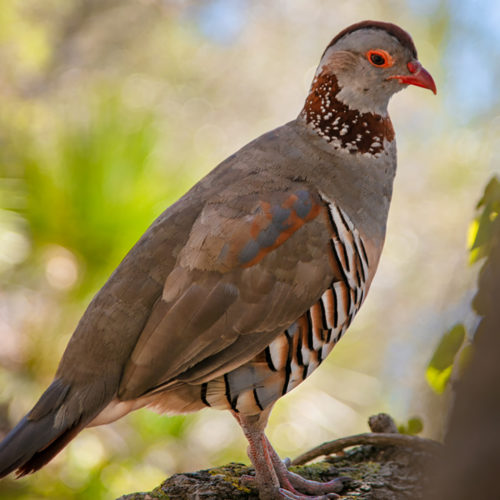EUROPA POINT
The furthest point away from the frontier and only 15½ miles or 25km from Africa.
On a clear day, which it is most days, you can see Jebel Sidi Musa the ‘other’ pillar of Hercules. The lighthouse was completed in 1841 and is still the only lighthouse outside of the United Kingdom that is administered by Trinity House, the authority that looks after all the UK and the Channel Islands lighthouses. Also, here is an impressive mosque built in the mid 1990’s with money donated by King Fahd of Saudi Arabia. Europa Point itself has its own original mosque, a church and the Shrine of Our Lady of Europe which is no ordinary church. The original building stood possibly from before 1309 and has gone through many changes and uses because of war and sieges. The bell tower used to be the original lighthouse when needed and the church itself has been the site of worship since those early times with pilgrimages to see the ancient statue of Our Lady of Europe and Child. She celebrated her 700th anniversary in 2009.
ALAMEDA GARDENS
For a peaceful afternoon stroll you can do no better than escape the cars and admire the botanical gardens.
Gibraltar’s Botanical Gardens were originally laid out in 1816. The Lieutenant-Governor at the time General Sir George Don as well as obtaining voluntary contributions also apparently legalised a series of lotteries to pay for the cost of creating the gardens. The beautiful garden, in the General’s words, “where the inhabitants might enjoy the air protected from the extreme heat of the sun.” After falling into some disrepair, it was revitalised in the 1970’s for all Gibraltarian’s to enjoy. With themed beds and both flora and fauna from all over the world the gardens contain some unique plants and trees. The gardens also boast a fantastic open-air theatre. Another interesting item is the fact that the Alameda is on the list of official wedding venues. They are normally held in an area known as the ‘Dell’ which has a bridge overlooking it.
Within the Alameda Gardens you will also find a unique Wildlife Conservation Park. This Park came to be as a result of many of the animals being rescued by the Gibraltar Customs from visiting vessels. Today they care for a unique collection of exotic animals to raise awareness about the importance of caring for and protecting these endangered species.
Although entrance in the Alameda Gardens is free there is a small entrance fee to enter the Wild Life Park.
DOLPHIN WATCHING
The Bay and Strait of Gibraltar is abundant in marine wild life.
If you are looking for an unforgettable experience for all the family, then a trip out into the Bay with one of the dolphin-watching boats is for you. We recommend the Dolphin Adventure team who will not only look after you but provide you with lots of interesting information about these captivating mammals. Although there is no guarantee, after all they are wild animals, you are likely to see either common dolphins, bottlenose dolphins or striped dolphins during your trip. If you are really fortunate you might even see a supper pod – or a gathering of hundreds of dolphins all feeding in the Bay or even see a visiting whale passing through the Strait!
Dolphin Adventure also provide specialised boat trips that provide views from the sea of the World Heritage Site including Gorham’s and Vanguard Caves (and neighbouring sea caves).
BIRD WATCHING
When it comes to bird watching (and we mean the feathered kind!) Gibraltar is the place to be.
Not only does it enjoy an abundance of wildlife in the sea and on land, but because of Gibraltar’s strategic geographical location it also enjoys a unique array of bird life. Each Spring and Autumn, the Rock becomes a staging post for hundreds of thousands of migrating birds flying between their breeding grounds in Northern Europe and their wintering areas in tropical Africa.
The Gibraltar Ornithological & Natural History Society (GONHS), founded in 1976, is a non-governmental, membership-based organization committed to research into and conservation of nature in Gibraltar and the region of the Strait of Gibraltar. They have put together a list of 311 species known to have occurred in Gibraltar, including the resident species such as Peregrine Falcons, Blue Rock Thrush and Gibraltar’s own Barbary Partridge. GONHS are the people to contact should you be interested in bird watching and are contactable through www.gonhs.org. As they say on their website ‘Birdwatchers and others with an interest in nature are always welcome.’
UNESCO World Heritage Site Viewing Platform
The Gorham’s Cave Complex was awarded UNESCO World Heritage status in July 2016 for its exceptional evidence of Neanderthal life over a span of 100,00 years. This platform is the best vantage point from which to see along the coast towards Gorham’s and Vanguard Caves.
OPENING HOURS:
Mondays to Fridays: 10.00hrs to 14.00hrs.
Weekends and public holidays: Closed.
EMAIL:
neanderthals@gibmuseum.gi
TELEPHONE:
(+350) 200 74289.
An entrance ticket is required to access this attraction.
TRAFALGAR CEMETERY
KEEP WALKING ALONG MAIN STREET AND YOU WILL EVENTUALLY COME TO THE REFERENDUM GATES.
Renamed after the 1967 referendum where Gibraltarian’s decided to remain under British sovereignty by a massive 99%. As you pass through the gates on the left is a small cemetery. It was here the two men wounded in the Battle of Trafalgar in October 1805 that died in Gibraltar were buried. Across from the cemetery is a memorial statue of Admiral Lord Nelson erected in 2005 on the 200th anniversary of the battle. Every year there is a wreath laying ceremony to commemorate the battle in this cemetery.
GIBRALTAR MUSEUM
The first mention of opening a museum was back in 1835 during a meeting of the Gibraltar Scientific Society. It wasn’t until almost 100 years later it actually happened.
On the 23 July 1930 the Gibraltar museum was founded and located in the home of the Principal Ordinance Officer, then known as Ordinance House or more colloquially known as ‘Bomb House’. It is located just off Main Street in Bomb House Lane behind the Bristol Hotel. It has a small room that shows a 15-minute film on the geology around the Rock including how it came to be. After that you can walk it’s few rooms and marvel at some interesting artefacts ancient and not so ancient covering the existence of more than 20,000 years of history. Whatever you do visit the Moorish Baths and, in the room just before you enter them you will see two cages full of oyster shells from the Roman period, shells bigger than a large bread roll compared to today’s tiny oysters. Don’t leave without seeing the Egyptian Mummy dating from 800BCE, found floating in the Bay in 1930 and the 1:600 scale model of the Rock made in 1865 accurate even down to the trees by Lieutenant Charles Warren. The same Charles Warren who 23 years later was Commissioner of the Metropolitan Police during the infamous ‘Whitechapel’ murders of 1888.
Moorish Baths
The remains of medieval baths built during the 14th Century Menindin Dynasty rule of Gibraltar.
Located beneath what is now the Gibraltar Museum, these ancient remains were actually used as stables during the British occupation of Gibraltar. In fact, one of the rooms was sufficiently filled to the level of the road to enable it to accommodate coaches, the horse drawn variety of course. Although smaller than originally built after the house was badly damaged during the Great Siege the baths are on the site of the Palace of the Governor of Gibraltar and are therefore, private baths. They consist of rooms similar to Roman ‘Hypocaust’ system of baths with a normal temperature room for undressing, a cold room and a hot room. Like the saunas of today moving between them cleanses the body by sweating the dirt away. The baths had channels under the floor through which warm air circulated heating the rooms.
An entrance ticket is required to enter the Gibraltar Museum.
GARRISON LIBRARY
This magnificent 200-year-old building houses many interesting archives and documents from as far back as 1704.
A young Lieutenant called Drinkwater having been in Gibraltar during the Great Siege of 1779 – 1783 and unable to leave the Garrison not even by ship because of the blockade, recalled how siege warfare could be mind numbingly boring as there were great swathes of time where the Garrison literally waited for the next period of shelling by the enemy. On his return to Gibraltar, the then Captain Drinkwater, requested that the Garrison had a library to help alleviate the boredom and provide some recreation. Officers often travelled with their own books, but men didn’t. The idea was well received by the Governor Sir Robert Boyd and both he and the Lieutenant-Governor, Major-General O’Hara donated money to help fund the cause, it was so that the library was founded in 1793. Originally in a building on Main Street the library grew large enough to need its own premises including reading rooms, a garden to take refreshments and rooms for games like bridge etc. Using land the Governor had for grazing his horse and cattle, the construction began in 1800 and was completed in 1804. Other buildings were added around it and a new wing added in 1867 but the building is now as it was then, including the bookcases and some of the original furniture. Interestingly there is also the original ‘sand glass’ which was used to prevent gentlemen ‘hogging’ The Times newspaper for too long!
Also, part of the construction was the premises on which the Gibraltar Chronicle was put together and printed. Gibraltar’s ‘national’ newspaper was first printed as a garrison newsletter on the 4th May 1801. It is one of the oldest newspapers still in print in Europe and scored a world exclusive in October 1805 when it reported victory at the Battle of Trafalgar and the death of Lord Nelson.
MAIN STREET
Situated at the beginning of the 800-metre-long parade of shops we call Main Street or Calle Real (Royal Street).
‘Casemates,’ located at the northern end of Main Street, has café bars and restaurants of all descriptions from where you can sit and relax and watch the world go by. All of Gibraltar’s life will walk past you and you may even spot the odd famous face from film or television in Gibraltar for a break. It was originally a barracks but more than that, as its name suggests, it was a store for ammunition hence the shape of all the buildings at one side of the square. The name comes from the Italian word ‘Casa Matta’ meaning ‘Armed House’. It also was the site of Gibraltar’s public executions the last one taking place in the 1860’s in full view of the Garrison.
Looking to the south of the square you will find Main Street and it is along this thoroughfare you will find everything a shopper would wish for! From perfume, alcohol, tobacco, clothing, linen to electrical goods like camera’s, games consoles, DVD’s and everything in between. As you reach halfway up Main Street, take a moment to look at the Piazza found in front of our Parliament and the John Macintosh Square, located behind the same Parliament Building which is also home to City Hall, home to the Gibraltar National Art Gallery. Further south, where the pedestrian area ends, you find the Courts of Justice inside of which John Lennon and Yoko Ono were married in March 1969. Just beyond that and to the right, is located the King’s Chapel also next to that is the Governor’s Residence, called the Convent where you can see the traditional changing of the Guard. The Convent was built in the late 1490’s and was originally home to a community of Franciscan Friars. This building sits resplendent across from the office of our Chief Minister known as No 6 Convent Place. Continue your walk through the arches of Referendum Gates and you will be at Trafalgar Cemetery and the Cable Car base station and Alameda Garden a further 5min walk beyond that.
CATALAN BAY & JURASSIC SAND DUNE
ON THE ROCK’S EASTERN SIDE YOU WILL FIND ONE OF GIBRALTAR’S GEOLOGICAL MIRACLES, EVIDENCE THE MEDITERRANEAN WAS ONCE A DESERT.
atalan Bay is a small fishing village on the eastern side of the Rock. Tradition tells us this small cove on the eastern side of the Rock was named after the Catalans that escaped the perils of the Napoleonic wars and settled in the area. The best way to view this area is from the Cable Car Top Station’s north platform. It is a great bird’s eye view over the village and old water catchment. The Caleta Hotel is located here as are several restaurants and a small sandy cove. Above the village is a huge slope resting against the side of the Rock. Stripped of the corrugated sheeting that once covered this huge expanse, the slope made of sandstone is now clearly visible as it was millions of years ago. It is accepted fact that the Mediterranean has been both desert and sea several times over the millennia. Not totally drying out but almost, sand from areas around the lower sea levels was blown against the Rock as drift sand to form the slope. This sand eventually became impacted into sandstone and was a natural catchment area for rain water during the times when Gibraltar had no water of its own. All Gibraltar’s water is now desalinated so the water catchment, as it is known, was dismantled although you can still see a few sheets left on one corner to give visitors an idea of what it looked like. Another interesting note is that Gibraltar has two water systems; a salt water system that is used for flushing and taking waste away and the clear desalinated system for consumption. Many of the older houses still have their original salt water pumps although often now used as a place to hang flower baskets.















